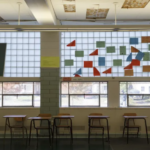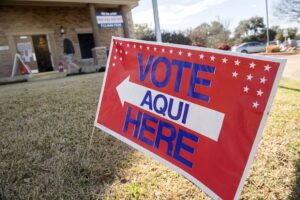Students are trickling back to Indianapolis Public Schools this year, marking the start of recovery from an enrollment dip during the pandemic.
Among the increase in students: children starting first grade after missing kindergarten last year.
This fall, IPS counted 31,795 students in its schools — an increase of about 600 students from the previous year. But the numbers are still below the pre-pandemic enrollment of about 32,300 students, including the three former state takeover schools that have returned to the district.
Like districts across the nation dealing with COVID disruptions, IPS has lost students to charter schools, private schools, and home schooling, Superintendent Aleesia Johnson said. Local factors, such as gentrification and housing instability, could also affect enrollment, she added.
But getting to the root of what’s causing enrollment changes is “a pretty complex question,” Johnson told reporters Tuesday, “and can’t be boiled down to just one thing.”
Enrollment trends will also drive crucial upcoming decisions on the future of the district, such as considering potential school closures, evaluating choice programs, and adding charter school partnerships.
In trying to attract students to stay in the district, “who’s making that choice, and why or why not, is a really important conversation,” Johnson said.
Here are several takeaways from IPS’s enrollment data.
Middle and high school enrollment is rebounding faster than in elementary grades.
IPS’s elementary enrollment remained lower than pre-pandemic levels in every grade except first grade, where Johnson surmised students were starting school after staying home from kindergarten last year.
But in grades 7-12, the district is serving even more students than it did in 2019-20. That’s likely in part due to innovation schools adding grade levels as they grow, Johnson said.
Enrollment is growing at choice schools and decreasing at neighborhood schools.
Since the launch of innovation schools in 2015, IPS’s charter school partnerships have helped staunch enrollment losses caused by families moving out to suburbs or choosing other schools.
In recent years, IPS has added more students as the district adds more charter partners. At the same time, neighborhood school enrollment has trended downward, one factor likely being that some have been converted into innovation schools run by charter operators.
The decline in elementary and neighborhood school enrollment could also be due to shifts in community demographics, Johnson said, from changes such as housing instability or gentrification. In gentrifying neighborhoods, more families could be moving in without school-aged children or opting out of local schools. At the same time, families in those neighborhoods could be pushed out to areas outside district boundaries.
Transportation also becomes a barrier to neighborhood school enrollment. The district buses students to choice programs but does not offer transportation to students who live within walking distance of a neighborhood school.
If families aren’t attending their neighborhood schools — which serve a higher proportion of students of color than choice programs — Johnson said the district needs to closely examine why and what it needs to do to improve those schools.
“What does it tell us if families don’t feel like that’s a choice they can make?” she said. “And how might we need to be thinking about the offerings of our schools, the structure of our schools, the experiences that students have in our schools — all of our schools — so that we are that choice that families want to make?”
IPS’s high-demand magnet programs continue to struggle with diversity.
At high-demand magnet schools — Butler Lab and Center for Inquiry schools located in more affluent and majority white areas — white students make up more than three-quarters of kindergarten enrollment in a district that serves nearly 80% students of color.
That’s because IPS’s enrollment policies allow students who live close to magnet schools or have siblings enrolled there to have priority in claiming available seats over other district students.
Nearly 90% of seats at those high-demand magnet programs go to students who are given preference because of where they live or sibling attendance, according to IPS.
IPS’s new virtual options draw almost all local students.
About 800 students have enrolled in the district’s two all-virtual options, Paramount Online Academy or Phalen Virtual Leadership Academy. Unlike other sprawling online schools, these two new virtual charter schools partnering with IPS almost exclusively serve students within district boundaries.
As a result, the two virtual schools are far more diverse than other Indiana virtual charter schools: Just over half of students at each school are Black.
While IPS’s remote learning options caused a stir with some families who worried about giving up their students’ seats at choice schools, the district board is expected to vote Thursday on changing enrollment rules to help those students return to their brick-and-mortar schools next year.
This article was originally posted on IPS enrollment rises as missing kindergartners return











More Stories
More West Virginia schools will participate in opioid abuse prevention program
Pennsylvania is increasingly underfunding special education, report finds
Memphis’ Kingsbury High School community steps up call for changes